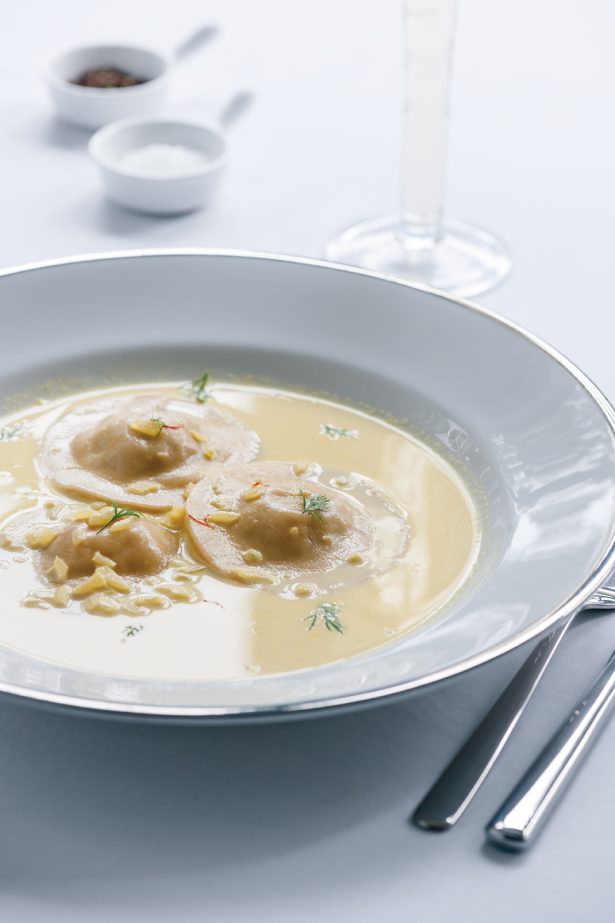|
25th
February 2021 |
Is too much gin a sin?GinGin : 4 New Regent Street Christchurch Luke Dawkins is a man who sucks the juice out of life and lives every inch of his aesthetic, quirky personality and infectious nature. We met about 2 years ago when I walked into GinGin Victoria Street; him on one side of the bar and me the other;… |
Prawn and Pumpkin Ravioli w Saffron Cream Sauce

Exceptional flavours that marry very well – the plump subtle brine of the prawns & sweet, and earthy roasted pumpkin.
Prep Time: 35 min
Cook time: 30 mins + chilling time
Serves: 4 - 6
Ingredients
BASIC PASTA DOUGH
100g high grade flour
1/2 tsp salt
1 egg, lightly beaten
2 tbsp olive oil (lemon infused is divine)
OR 1 pkt dumpling skins
PRAWN & PUMPKIN MOUSSE
1/2 small pumpkin, peeled, deseeded, diced
2 tbsp olive oil, plus extra for drizzling
1 tsp smoked paprika
2 shallots, finely diced
1 clove garlic, crushed
2 cups raw prawns, shelled, deveined, roughly chopped
1 tbsp dill (or fennel fronds)
salt and freshly ground black pepper
zest of 1 lemon
SAFFRON CREAM SAUCE
150ml dry white wine
18 threads of saffron
1 shallot, finely diced
1 clove garlic, crushed
2 tbsp olive oil
200 ml cream
salt and freshly ground black pepper
dill tips for garnish
Instructions
DOUGH :If you want to make fresh pasta – in a medium-sized bowl, food processor or on your bench, combine the flour and salt. Make a well in the centre and add the egg. Mix or pulse. Drizzle in the olive oil and keep mixing until you’ve formed a small ball of dough.
Otherwise : for a quick hax – use dumpling skins and jump to ravioli and filling below.
Lightly flour your bench and knead the dough for 3 – 4 minutes until it feels bouncy! Cover with cling wrap and rest for a min of 15 minutes before rolling out.
FILLING : Preheat the oven to 190c. Place the pumpkin in a roasting pan, drizzle with olive oil and sprinkle with paprika, salt and pepper. Toss the pan to coat. Bake for about 20 minutes or until the pumpkin is nice and tender. Set aside to cool, then mash with a fork.
Heat 2 tbsp olive oil in a frying pan and sauté the shallots and garlic until soft, translucent and fragrant. Remove from the pan and set aside to cool.
Either roughly chop the prawns or drop in a food processor and blend until roughly minced. Add the salted onion and garlic, mashed pumpkin and dill. Gently pulse or mix until just combined. Season with salt and pepper, then stir through the lemon zest. Transfer to a bowl and chill for 20 minutes.
SAUCE : Pour the wine in to a jug and sprinkle in the saffron, leave for about 20 minutes or until the wine has begun to take on the colour of the saffron.
In a small frying pan, sauté the shallot and garlic in a little olive oil until soft and translucent. Slowly pour in the wine and saffron. Bring to a gentle simmer and cook until reduced by three-quarters. Whisk in the cream, then simmer for a further 5 minutes, taste and season.
RAVIOLI : Remove your rested dough from the fridge and using a pasta machine, cut the pasta into quarters and begin the rolling process. Start on the thickest ending with the thinest setting. You will need 2 long thin sheets of pasta.
Place 1 sheet of pasta on a bench lightly dusted with flour or individual dumpling skins. Dot 1 tsp of the prawn and pumpkin mousse at regular intervals (let’s say about 2 finger spaces apart) along the length of the pasta or each skin. Lightly brush with water around each mound then cover with the other sheet of pasta.
Using your fingers, lightly press around the fillings to seal and to push out any air bubbles. Use a cookie or pasta cutter to shape and cut your ravioli parcels to your desired round or square shape.
Or you could cut shapes out of the pasta in advance, cutting two for each ravioli to make top and bottom, use water to seal the edges and don’t forget to get rid of any air bubbles.
Place on a floured tray until you’re ready to cook them.
Cook the ravioli in a large saucepan of salted boiling water. Once they float to the top they’re cooked, which will take about 3 – 4 minutes. Drain (keeping a 4 tbsp of the water to add to the sauce.
Add the water to the sauce, when reheating.
Serve : Stir the ravioli through the sauce and serve garnished with extra dill and grated parmesan.
Jax Says : For my pasta, I always used a ratio of 1 egg to 100g flour. You can also use most types of general-purpose flour, but once you’ve mastered the art, have a go using ’00’ flour which is authentically Italian.
Browse recipes by category
- A Bit on the Side
- Baking
- BBQ
- Beef
- Breakfast
- Canapes and Starters
- Chicken
- Crowd-Pleasers
- Dairy Free
- Desserts
- Featured Recipe
- Fish
- Game
- Gluten Free
- Hot Chilli Sauce Tips!
- Jamaican
- Jax Food Hax
- Jax Jerk Marinade
- Keto
- Lamb
- Marinades & Dressings
- Oils, Pestos and Dips
- Paleo
- Pasta
- Pork
- Salad
- Salmon
- Seafood
- Sides
- Soup
- Starter
- Vegan
- Vegetarian
- Vietnamese
Latest News
|
23rd
October 2019 |
Good in the ‘Hood : The Permit RoomThe Permit Room 779 Colombo Street Lunch Menu : $5 – 20 Dinner Menu : $10 – $36 “Welcome to the days of East – Indian prohibition. As a visitor, inside these four walls, the laws against extravagance don’t apply. The Permit Room has attained a license from the authorities in your name. Tonight you… |
